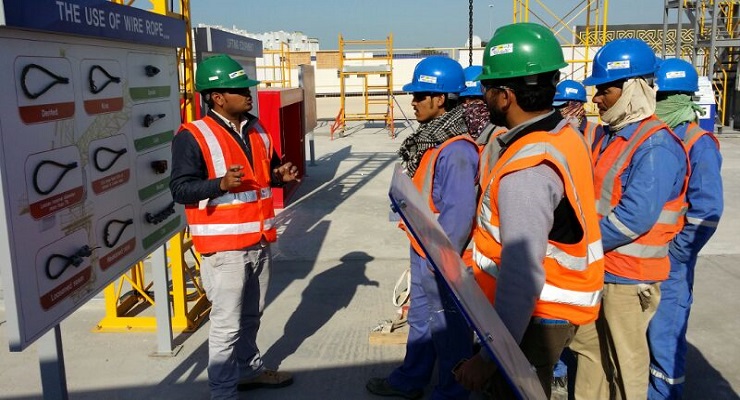Process Safety Audit

Fire Load Calculation and Fire Risk Assessment
September 11, 2023
Employee Safety Training at Various Levels Changing Safety Culture and Mindsets
September 12, 2023Introduction
Amidst the complex and ever-evolving industrial landscape, the importance of process safety audits cannot be overstated. Ensuring that systems and protocols are in place to prevent accidents, protect workers, and safeguard the environment is paramount. This article delves into the significance of process safety audits and their role in averting catastrophic failures.
Understanding the Importance of Process Safety Audits
In a world where industrial processes have become increasingly intricate, it is crucial to comprehend why process safety audits are indispensable. These audits serve as a proactive measure to identify potential hazards, evaluate existing control measures, mitigate risks, and foster a culture of safety within organizations. By conducting regular assessments, companies not only fulfill their legal obligations but also demonstrate their commitment to prioritizing the well-being of employees and communities.
Every industrial process carries a certain level of risk, and ensuring safety within these processes is of utmost importance. However, even with robust safety measures in place, accidents can still occur. The consequences of such accidents can be disastrous, resulting in injuries, environmental damage, and significant financial losses. This is where the concept of Process Safety Audits comes into play.
In this article, we will delve into the world of Process Safety Audits and explore their significance in mitigating potential disasters. We will unravel the story behind process safety failures that have shaped our understanding of the importance of audits. Furthermore, we will provide a step-by-step guide on how to conduct a comprehensive process safety audit to identify hazards and implement corrective actions effectively.
Understanding the Importance of Process Safety Audits
Process safety audits play a pivotal role in safeguarding industries and protecting the well-being of workers and the environment. These audits are not merely bureaucratic exercises but, rather, essential tools that ensure organizations are operating safely and effectively. By systematically assessing procedures, equipment, and personnel involved in high-risk processes, process safety audits help identify potential hazards and vulnerabilities that might otherwise go unnoticed.
One must comprehend that process safety is not an optional luxury; it is an imperative need for any responsible industry. It goes beyond compliance with regulations; it reflects an organization’s commitment to prevent accidents, protect lives, and preserve resources. Understanding the importance of process safety audits empowers companies to proactively manage risks, make informed decisions about resource allocation, and foster a culture of continuous improvement.
The Story behind Process Safety Failures
Behind every process safety failure lies a cautionary tale, a narrative of missed opportunities and devastating consequences. These stories serve as powerful reminders of the importance of conducting thorough process safety audits.
One such story takes us back to the tragic events that unfolded at a chemical plant in 1984. The city of Bhopal, India was forever scarred by one of the deadliest industrial disasters in history. Methyl isocyanate (MIC), a highly toxic chemical used in pesticide production, leaked from a storage tank, resulting in the release of a lethal cloud. Thousands lost their lives and countless others were left with severe health issues.
What makes this story particularly haunting is that it could have been prevented. A lack of proper maintenance procedures, inadequate safety systems, and insufficient training were among the many factors that contributed to this catastrophe. It serves as a stark reminder that failing to prioritize process safety can have catastrophic consequences for both human lives and the environment.
The Role of Process Safety Audits in Preventing Disasters
Process safety audits play a pivotal role in safeguarding industrial facilities and preventing catastrophic disasters. These audits act as a proactive tool to identify shortcomings, evaluate control measures, and ensure that proper protocols are followed to maintain the integrity of critical processes.
By conducting regular process safety audits, organizations can identify potential hazards before they escalate into serious incidents. Audits provide an opportunity to thoroughly assess the effectiveness of existing safety systems and procedures, allowing for timely adjustments and improvements. This comprehensive evaluation enables companies to mitigate risks significantly, reinforcing their commitment towards the well-being of employees, communities, and the environment.
Step-by-Step Guide to Conducting a Process Safety Audit
Conducting a process safety audit requires meticulous planning and attention to detail. By following this step-by-step guide, you can ensure a comprehensive assessment of your organization’s safety protocols, identifying potential hazards and implementing corrective actions to mitigate risks.
Gathering the Right Information: Identifying Potential Hazards
Begin by collecting all relevant information regarding your organization’s processes. This includes gathering documentation such as standard operating procedures, maintenance records, incident reports, and previous audit findings. Conduct interviews with employees at all levels to gain insights into potential hazards that may arise during operations. By compiling this data, you can create a comprehensive understanding of your organization’s unique risks.
Assessing Existing Controls: Are They Effective?
The next step involves evaluating the effectiveness of existing controls in place within your organization. Review safety policies and procedures, ensuring compliance with industry standards and regulations. Assess the adequacy of engineering controls, such as ventilation systems and emergency shutdown mechanisms. Evaluate administrative controls like training programs and work permits to determine if they effectively mitigate risks. Additionally, consider the use of personal protective equipment (PPE) and its proper utilization in safeguarding employees.
Gathering the Right Information: Identifying Potential Hazards
When it comes to ensuring process safety, knowledge is power. In this crucial phase of the process safety audit, the focus lies on gathering accurate and comprehensive information about potential hazards within the system. This step forms the foundation for developing effective risk management strategies and mitigating potential risks.
During this stage, auditors meticulously examine and analyze all aspects of the operation, ranging from equipment design and maintenance procedures to chemical handling protocols. By conducting thorough interviews with personnel involved in various stages of the process and reviewing relevant documentation, auditors gain a deep understanding of how each element contributes to overall process safety.
The goal is not simply to identify obvious hazards but also to uncover hidden or latent risks that may have otherwise gone unnoticed. By taking a proactive approach in identifying potential hazards, organizations can make informed decisions regarding risk mitigation measures and ensure a safer working environment for their employees.
Assessing Existing Controls: Are They Effective?
Within the realm of process safety audits, a critical aspect is evaluating the effectiveness of existing controls. This step requires meticulous attention to detail and a comprehensive understanding of the specific processes and equipment in place. By thoroughly assessing existing controls, organizations can identify potential gaps or weaknesses that may compromise safety.
During this phase, auditors delve into the intricate mechanisms and systems that govern operations. They meticulously analyze safety protocols, maintenance procedures, emergency response plans, and other crucial elements. Auditors utilize their expertise to scrutinize each control measure in place, determining whether it meets industry standards and best practices.
This assessment not only involves reviewing documentation but also conducting interviews with personnel involved in the implementation and maintenance of these controls. The goal is to gain a complete picture of how these measures are being utilized on a day-to-day basis. It is essential to evaluate whether employees understand their roles and responsibilities related to process safety measures.
In this quest for effectiveness, auditors seek evidence that demonstrates compliance with regulations, adherence to recognized standards such as OSHA’s Process Safety Management (PSM), and successful implementation of risk reduction strategies. They assess whether these controls have been adequately maintained throughout their lifespan or if there are signs of wear or decay that could potentially impact safety.
By assessing existing controls in such depth, organizations gain invaluable insights into their strengths and weaknesses. This knowledge empowers them to address any shortcomings promptly while reinforcing effective measures. Ultimately, this evaluation fosters an environment where continuous improvement becomes embedded within the organization’s culture—ensuring a safer work environment for all stakeholders involved.
Identifying and Addressing Process Safety Gaps
When conducting a process safety audit, one of the most crucial steps is identifying and addressing any existing gaps in the safety measures. These gaps can be potential hazards that have been overlooked or areas where the current controls are not effective in mitigating risks. By thoroughly examining the systems, procedures, and equipment involved in the process, auditors can uncover critical gaps that could lead to disastrous consequences if left unaddressed.
Addressing process safety gaps requires a comprehensive and systematic approach. It involves analyzing data collected during audits, reviewing incident reports, consulting relevant industry standards, and engaging with key stakeholders. Once identified, these gaps must be prioritized based on their severity and potential impact. Corrective actions need to be defined clearly and promptly implemented to close these gaps effectively. This may involve updating procedures, enhancing training programs, redesigning equipment or implementing additional control measures.
The ultimate goal is not only to bridge these gaps but also to ensure that similar issues do not arise again in the future. By diligently identifying and addressing process safety gaps through audits, organizations demonstrate their commitment to continuous improvement and safeguarding both their employees’ well-being and operational integrity.
Implementing Corrective Actions: Mitigating Risks
Once potential hazards and process safety gaps have been identified through a thorough process safety audit, the next crucial step is to implement corrective actions that effectively mitigate risks. This proactive approach not only prevents accidents and disasters but also fosters a culture of continuous improvement and safety consciousness within the organization.
Implementing corrective actions involves a systematic process of addressing each identified hazard or gap in a well-planned manner. It requires collaboration among various stakeholders, including management, engineers, operators, and maintenance personnel. The goal is to develop practical solutions that not only eliminate or minimize risks but also optimize overall operational efficiency.
An effective strategy is to prioritize corrective actions based on their potential impact on process safety. High-risk areas should be addressed promptly and with utmost attention. This can involve implementing engineering controls such as redesigning equipment or modifying processes to eliminate hazards at their source. Additionally, administrative controls like improving standard operating procedures or enhancing employee training programs can further strengthen the overall risk mitigation efforts.
It is vital to establish clear timelines for implementing these corrective actions and assign responsibility to ensure accountability. Regular follow-ups are necessary to track progress and evaluate the effectiveness of implemented measures. Continuous monitoring, feedback loops, and periodic reviews contribute significantly to refining existing controls and identifying new opportunities for further risk reduction.
Creating a Safety Culture: Engaging Employees
In order to ensure a successful process safety audit, it is crucial to create a safety culture within the organization that actively engages employees. A strong safety culture not only promotes compliance with regulations and best practices but also fosters an environment where individuals take ownership of their own safety and the safety of others. Engaging employees in the process empowers them to identify potential hazards, contribute their ideas for improvement, and actively participate in creating a safer workplace.
One effective way to engage employees is through regular communication channels that prioritize safety-related information. This can include newsletters, bulletin boards, or digital platforms where employees can access relevant updates and share their thoughts. By keeping everyone informed about ongoing audits, sharing success stories from previous audits, and highlighting the importance of their role in maintaining a safe work environment, organizations encourage a sense of belonging and collective responsibility.
Tips for a Successful Process Safety Audit
Conducting a thorough and effective process safety audit requires careful planning, attention to detail, and a commitment to continuous improvement. Here are some valuable tips to ensure your process safety audit is successful:
1. Engage with all stakeholders: Involve employees at all levels of the organization in the audit process. Their input and expertise can provide valuable insights into potential hazards and control measures.
2. Use a multi-disciplinary approach: Ensure that the audit team consists of individuals with diverse backgrounds, including engineering, operations, maintenance, and HSE (Health, Safety, and Environment). This diversity will enhance the breadth of knowledge when identifying gaps in the system.
3. Be objective and unbiased: Approach the audit with an open mind. Avoid preconceived notions or personal biases that may cloud judgment or overlook critical issues.
4. Thoroughly review documentation: Carefully examine relevant documents such as Standard Operating Procedures (SOPs), incident reports, and previous audits to gain a comprehensive understanding of existing processes and identify areas for improvement.
5. Conduct interviews: Interview personnel involved in operating the processes under review. Gather their perspectives on potential hazards, control measures, and any concerns they may have regarding safety procedures.
6. Pay attention to human factors: Evaluate how human behavior can impact process safety by assessing operator training programs, competency assurance systems, fatigue management practices, shift handovers procedures etc.
7. Analyze historical data: Review incident reports or near-miss records to identify trends or recurring issues that require additional
Conclusion
In conclusion, the importance of process safety audits cannot be overstated. These audits play a crucial role in identifying potential hazards, assessing existing controls, and implementing corrective actions to prevent disasters in industries that deal with complex processes. By following a well-structured audit process and fostering a strong safety culture, organizations can mitigate risks and ensure the well-being of their employees and the surrounding communities. Remember, it is through diligent auditing and continuous improvement that we pave the way for a safer future, where accidents are minimized and operations run smoothly. Let us embrace the power of process safety audits to create a world where safety is never compromised.




